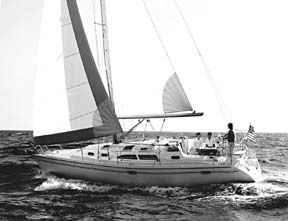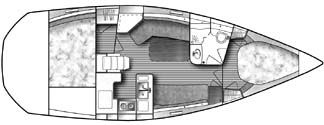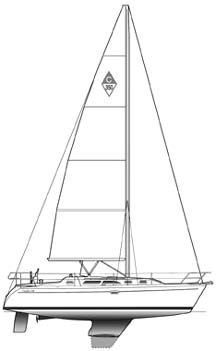Catalina Yachts has been at or near the pinnacle of the production boatbuilding industry since Frank Butler formed the company in 1969. The company endured the market downturns of the 1970s and 1980s while competitors fell by the wayside. Butler succeeded by producing sailboats that offered customers a “touch” of speed, and comfort, while maintaining moderate pricing.
When a manufacturer attempts to combine seaworthiness, accommodations, and mid-level pricing, compromises are involved. In Catalina’s case, compromises typically were reflected in average workmanship in some areas. The insides of cabinets, for example, often revealed unfinished fiberglass. Cabinet doors and drawers were often misaligned. A mantra of Catalina owners became, “Well, it ain’t a Hinckley.”
However, through it all, Butler’s personal involvement in warranty issues resulted in a loyal following.

The company now builds boats ranging in size from 14 to 47 feet at plants in California and Florida. Roam the docks of any good-sized marina and you’re likely to find more than a few Catalinas of 22, 25, 30, and 34 feet. Butler’s much-modified 36-footer has been in production since 1983, and is still popular with cruisers. Similarly, the Catalina 27 has become for many a popular racer, for others a comfortable cruiser.
The company dominated its segment of the market prior to the entrance of Hunter Yachts and, eventually, the emergence of a major European competitor, Beneteau.
Though the majority of the pie is now being sliced three ways, Catalina continues to prosper. It enjoys such a strong position in the marketplace that, in the words of chief designer Gerry Douglas, when the time arrived to design a 35-footer, “I decided I had license to do something different.”
The objective was to introduce a new model that would fit between two bookends, 34-foot and 36-foot models that have played a prominent part in the company’s success. At the same time, Douglas did not want the new boat to affect the sales of bread- and-butter products.
The result is a radically different boat, the seeds of which were sown in the late 1990s with the introduction of the Catalina 310 (reviewed with two other boats in the April 1, 2002 issue).
Design
Examine a Catalina sales brochure and you’ll notice a striking similarity between all of the boats the company produces, especially those introduced in the last 10 years. Bows are more plumb than early versions, sterns are reversed to make room for swim platforms, and sheer lines are fairly flat. The fronts of cabintops are now more downward sloping than traditional models. The Catalina 350 fits this general profile, with one marked exception: She’s significantly wider in the beam, an especially noticeable feature when she’s sitting next to one of the older models, or when viewed from the bow. And, when viewed from astern, it’s obvious that the beam has been carried farther aft.
Traditional models, including the 34-footer and 36-footer, have typically sized and arranged living and sleeping compartments common in the production building world. As a consequence, differentiating between Big Three models is typically a matter of detail and subjective issues. Gerry Douglas says this model, introduced in October, 2002, heralded a totally new concept for the company.
Like the Catalina 310, an out-of-the-mainstream sloop introduced in the late 1990s (reviewed in PS, April 1, 2002), the 350 “follows a theory about the different ways people use their boats.”
The 350’s connection to the 310 heritage is striking. Designed as a two-person boat, or for a couple with toddlers, the 310 gave up sleeping areas in exchange for proportionally larger, wide-open living areas in the main cabin. However, the effect is limited by the boat’s length.
Similarly, the 350, says Douglas, “is not a bigger 34, or smaller 36. It’s designed for a couple with children, or owners and two guests; sailors who don’t need as many berths.” Translation: this is not a 35 – footer designed to accommodate sleepers in the saloon.
Though Catalina always has favored the creation of large living spaces, the asymmetrical shape of the main cabin on the 350 carries the concept to a new extreme. Her 13′ beam is 13″ wider than the 36 MKII. “It has a big-boat galley, big-boat head, and large forward cabin to pamper owners. It is not a conventional design,” Douglas says. “However, we did this without making any significant compromises in living spaces or performance. It has more headroom (6’9″) than you would expect in a conventional 35-footer, but we accomplished that by lowering the cabin sole, because we didn’t want to elevate the cabinsides.”
A byproduct is a much shallower bilge.
“The hull shape is slippery,” says Douglas, “with a fine entry, sharp knuckle on the bow, long run aft, and shallow rocker fore and aft.”
Again, almost the full beam is carried almost all the way aft. This is the way of many production cruising designs these days. The practice has its advantages—it increases room down below; it makes for a bigger cockpit and swim platform; and it increases initial stability, assuming that the waterline beamis continued aft, too. On the downside, there can be steering difficulties, depending on the effectiveness of the rudder, the rest of the underwater shape, and the center of effort in the sailplan—and it can make a boat look just plain fat.
The design begs other comparisons to her sisters. Her I measurement is 46′ 9″, identical to the 36 MKII, and only 4″ taller than the 310. Her boom is only 6″ inches shorter than the 36 MKII, so she carries 276 square feet of canvas in the mainsail, compared to 266 square feet in the 36-footer. Her J measures 14′ 5″, one inch more than the 36 MKII, so masthead headsails will carry nearly identical sail area.
Her “approximate basic weight” is 13,635 pounds, 135 pounds more than the MKII’s 13,500 pound “designed weight,” but her 5,835 pounds of ballast in a 6′ 8″ fin keel is 165 pounds less, and nearly one foot deeper than the 36 MKII.
On paper, the 350 has more sail power than the 310 and 36 MKII, with a displacement-to-length ratio toward the lighter end of moderate.
Ultimately, however, performance will be measured on the water, and will be a function of hull shape, crew performance, and the amount and location of gear and provisions. We didn’t find the boat too fast on our test sail. More on that later.
The 350 has been well received in the marketplace; hull #175 came off the production line 12 months after its introduction. In separate conversations with three buyers, including two former racers who have celebrated their half-century birthdays, we were told that the 350 appeals on three levels: interior size and layout, cockpit space, and ease of handling. Interestingly, performance was a minor consideration.
Deck Layout
Because Douglas’ intent was to produce a user-friendly vessel, he coupled a large cockpit with an arrangement of standing rigging and deck hardware that do not interfere with crew comfort.

The cockpit is spacious. The cockpit locker is large enough to stow an inflatable dinghy, and carries shelves on the hull side. Cockpit length on the centerline is 8′ 6″, though a steering pedestal and table with drop leaves reduce the space. Seats 8′ long allow room for sleeping outdoors on a 17.5″ wide surface. Backrests are 13″ tall. There are also “observation seats” in the stern pulpit, equipped with stainless steel drink holders.
Though the boat has a removable helm seat, the skipper may be most comfortable steering from a position next to a trimmer; a shorthanded sailor will have jib sheets at his fingertips. The cockpit will seat six comfortably on flat water, but odds are that when sailing to weather in fresh conditions, crew will sit atop the cabin or on the rail. A gate at the stern allows access to the swim platform, which has two storage compartments and a boarding ladder.
Shrouds supporting the double- spreader rig at the base of the cabin are attached to ball sockets that allow them to move with hull flex, avoiding the chronic problem of leaks at the intersection of deck, shrouds and chainplates. Genoa track is inboard, allowing easy movement forward on wide decks. The mainsail traveler is located forward of the companionway, producing mid-boom sheeting, with its pluses and minuses: Though the traveler is out of the cockpit, trimming the mainsail requires more power, and control of the leech is reduced.
Halyards, vang, and sail controls are clustered at the base of the mast and led through ball- bearing blocks to sheet-stoppers and winches atop the cabin. Standard equipment includes two self-tailing halyard winches, and two primaries for jib sheets. Most of the deck gear is supplied by Garhauer, long a supplier to Catalina.
On balance, we’d describe the deck layout and gear as typical of that offered by production builders.
Accommodations
Step belowdecks and comparisons to other 35-foot production boats become difficult. This boat is all about space. The main cabin measures 9′ 6″ on the centerline from the base of the companionway ladder to the port bulkhead at the head. The cabin at its widest point, measured from the backs of settees, is 10′ 5″. To put that in perspective, a bedroom in an average-sized apartment is 10′ x 12′.
Two hatches on the cabintop and five ports on each side of the cabin and hull add light that increases even more the feeling of spaciousness.
Seating in this cavern is on a settee to port measuring 66″, and another to starboard measuring 73″. The latter can be bisected by a teak-veneered drop-down game table. The dining table, located to port, measures 31″ x 48″ and, with a bench on the centerline, will seat six. It can also be stored and replaced by a smaller “cocktail” table.
The U-shaped galley has room for one person, who will be well-braced in a seaway, and is adequately equipped with standard gear—a two- burner stove-oven combination, reefer-icebox combination, and double stainless sink. Counter space is at a premium, though storage in cabinets and drawers is typical of a boat this size. A cutout provides space for a microwave above the stove.
The nav station is tucked into a corner to port, requiring the navigator to sit facing aft on a cushion at the end of the settee. The size of the table, 25.5″ x 29″, reflects the tendency of today’s skipper to rely on electronics at the helm or cockpit bulkhead, and the use of chart kits, rather than full-sized NOAA charts. Since the 350 will see use primarily as a coastal cruiser and dockside getaway. the arrangement is suitable.
Douglas does not exaggerate the size of the skipper’s quarters forward. Skipper and mate will bed down on an island located center-stage in the stateroom. The bunk measures 59″ x 77″, with easy assess from both sides. The area is enclosed by teak ceilings and shiny white surfaces accented by three reading lights. Storage is in two lockers and drawers below the berth. The area provides a comfortable retreat, although island-type bunks don’t provide security for people trying to sleep when the boat is under sail. They’re meant for use at anchor or in a marina.
The head is a full-sized compartment furnished with a shower enclosed by a folding door.
A second stateroom aft has a 55″ x 88″ berth and hanging locker.
The engine compartment is well- insulated; we talked at normal voice levels while motoring.
Construction
The boat is constructed of five major moldings, following a system that originated with the Catalina 470. Major components include the hull, a fiberglass sub sole grid, deck, deck liner, and interior liner. The overall effect of this combination is to provide a stiff hull and deck, solid base for the interior and cabinetry, and to disperse loads.
The hull is solid hand-laid fiberglass consisting of a vinylester skincoat and layers of chop, mat, and roving. The grid system, similar to those employed by some other production manufacturers, produces a checkerboard of fiberglass supports in a pattern of athwartships beams and longitudinal stringers. The grid spreads loads from the shrouds while providing support for the mast, engine, and tanks. An improvement is that all of the boats have wiring and plumbing in conduits, easing the addition of accessories and maintenance.
The deck is constructed of layers of chop, mat, and roving, cored with end-grain balsa. Pre-tapped aluminum plates are bedded in areas where deck hardware will be installed. This is a relatively new alternative to bolts, nuts, and backing plates. It prevents deck leaks, but will be a big headache if the threads in the plate get stripped, galled, or corroded.
Douglas says Catalina is building to meet CE and ABYC standards.
Performance
With assistance from Tim Fulbright of Sail Place in Waukegan, IL, and owner Leon Bayless, we tested a brand-new 350 on Lake Michigan on flat water under clear skies.
The boat was equipped with Catalina’s in-mast mainsail furling system, and a 135-percent genoa. The Universal 4-cylinder, 35-horsepower diesel and two-blade fixed propeller powered the boat at 5-6 knots at three-quarter throttle. To demonstrate her handling capability to the new owner, Fulbright easily backed between rows of boats on mooring buoys.
We were not impressed with the boat’s speed under sail. Even though the Raytheon instruments hadn’t been calibrated, they wouldn’t have told much of a different story if they had been. Sailing in 6-8 knots of wind we were unable to exceed 3.5 knots of boatspeed sailing close-hauled or even on a reach. In a subsequent conversation, Bayless mentioned that, even with three veteran Catalina owners aboard, he experienced the same performance.
Gerry Douglas considered the boat’s poor performance to be an anomaly. “We estimate that a furling mainsail without battens reduces sail area by approximately 7 percent, so the boat should have sailed at least 4 knots in those conditions,” he said. “It’s extremely difficult to induce shape in an unbattened sail.”

Amen. Buyers considering a mechanical type of sail-shortening system might do well to consider one of the in-boom alternatives. Better yet, first try a simple, well-adjusted slab-reefing system and lazy jacks.
Two other owners with whom we talked, both successful racers of other boats, shared their reasons for going to this 350. The first owner, who lives in Los Angeles, said, “I decided to quit racing, sold a J/120, and purchased a Catalina 310. It was too small. My first impression of the 350 was that it was too beamy, until I went below and saw how well thought-out the interior is.
“It motors at 6 knots, and we’ve hit 7.5 knots on a reach in 16-18 knots of wind with the gennaker.”
The second owner, from Santa Monica, told us, “After racing a Schock 35 for 16 years, I quit racing. We sail in 10 knots of wind 80 percent of the time. I tested a boat with in-mast furling, but it was too slow, so I ordered a main with full battens. We sail to within 30 degrees of the apparent wind at 5 knots in 8 knots of wind, and hit 7 knots on a reach in 18 knots of wind. She’s stiff as a rock, compared to the Schock. My wife is exhilarated that sailhandling is so easy. On a 240-mile shakedown cruise, the only problem we found was a sticky door.”
Pricing
The 350 is built at Catalina’s Florida factory. A typical price for a 350 with standard equipment, including sails, is $123,500, plus shipping and commissioning. Owners tell us that the addition of electronics, oversized headsails, and upholstery upgrade, puts the final tally at $140,000-150,000.
Conclusion
Gerry Douglas followed a non-traditional path in designing the Catalina 350, but the man is canny, and knows his market. Considering the demographics of today’s cruising population (we aren’t getting any younger, are we—or stronger?) the demands on everyone’s time, the need to sail shorthanded more often than not, and the fact that many people use their boats not as passagemakers but as get-away zones, Douglas really didn’t take a huge risk here. In fact he took a bigger risk with the predecessor 310, which was the first of his boats featuring larger spaces for smaller crowds, a scheme that makes eminent good sense. The 310 was well-received, as it should have been.
Judging from our experience sailing the test boat, but also extrapolating a bit, we think Douglas is pushing the accommodations versus performance balance as far as it can go, ending up with a really generous situation belowdecks and a boat that sails…okay. Sailors in light-air regions will want a mainsail with full battens and some roach, a light-air gennaker, and a clean bottom. And they shouldn’t load the boat with a lot of gee-dunk. Of course, this is true for all boats.
But again, Douglas knows his customers. As one owner told PS, “I don’t care if it’s a half-knot slower than my J/109; my wife and I can sail it by ourselves.” (We’d venture to guess that it’s a lot more than a half-knot slower than a J/109.)
When owner Bayless realized that he’d sacrificed a level of performance for comfort, he said “I’m still satisfied with my decision.”
The Catalina 350 will appeal to that segment of the market that includes families with small children, as well as empty-nesters who no longer need separate quarters for more than three passengers; and get-away couples for whom boatspeed really isn’t that important. Certainly, most of the feedback we received about the boat emphasized creature comforts—large cockpit, good swim platform. large saloon, and maximum stowage for gear.
Contact – Catalina Yachts, 818/884-7700, www.catalinayachts.com




































